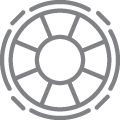Today’s global marketplace is a constantly changing scenario of new technologies, economic swings, emerging customer expectations, and organizational capabilities. Many organizations struggle to keep up with all these changes and hold onto a secure position in their industry.
Amidst all these changes and internal angst, most corporations continue to trudge on with the organizational tools they have practiced for the past two centuries. These tools are all elements of bureaucracy – the new way of working when factories began to replace farms as the means of earning a living. Bureaucracy remains the dominant form of organizing today. You will no doubt recognize these bureaucratic tools which have provided structure and uniformity to the world of work:
1. Task Specialization (job fragmentation)–specialize tasks and reduce them to the smallest possible work cycle.
2. Performance Standardization (find the one best way)–do the work the same way every time. This is epitomized by the assembly line, but even administrative processes can be organized like an assembly line.
3. Central Decision Making (unity of command)–only those in authority should make decisions.
4. Uniform policies (that’s what the book says)–treat all parts of the system alike.
5. No duplication of functions (that’s not my job)–everyone does only their own job.
6. Reward physical activity (the hired hand)–pay a person only for physical labor and skills.
But as the world has marched on in the past two centuries, today’s marketplaces require not only bureaucracy’s structure and uniformity, but also greater flexibility and adaptability to stay in alignment with all those external changes. Here are some organizational tools that can add resilience and flexibility to your operation:
- Multi-skilled career paths: team members might be cross-trained over time in each of the team’s tasks. This enables individuals to contribute spontaneously to problems in many different areas.
- Self-sufficient teams: individuals share leadership responsibilities formerly held by their manager. This applies the multi-skilled task development approach to leadership competencies. Self-sufficient teams require little outside support to manage their business.
- Cross-functional teams: neighboring units collaborate routinely to optimize the whole business process, not just their own individual pieces.
- Self-sufficient business units: have all the resources within their boundaries to handle their daily business. This extends the self-sufficient team concept to an entire operation with similar excellent results.
- Stakeholder partnerships: the players move from merely transacting their business agreements to becoming business partners who do whatever is required for both parties to survive.
- Business alliances: the organization reaches outside for special needs apart from the daily business (research, technology, alliances, etc.).
We have years of experience in many industries and cultures with each of these high-performance tools to help you boost your resilience and flexibility.

